Doro Wat (Spicy Ethiopian Chicken Stew)
This post may contain affiliate links. See my disclosure policy.
There is a reason why Doro Wat is the national dish of Ethiopia and one of the most famous of all African dishes – it’s fabulous! This authentic Doro Wat recipe captures the very best of Ethiopian cooking!
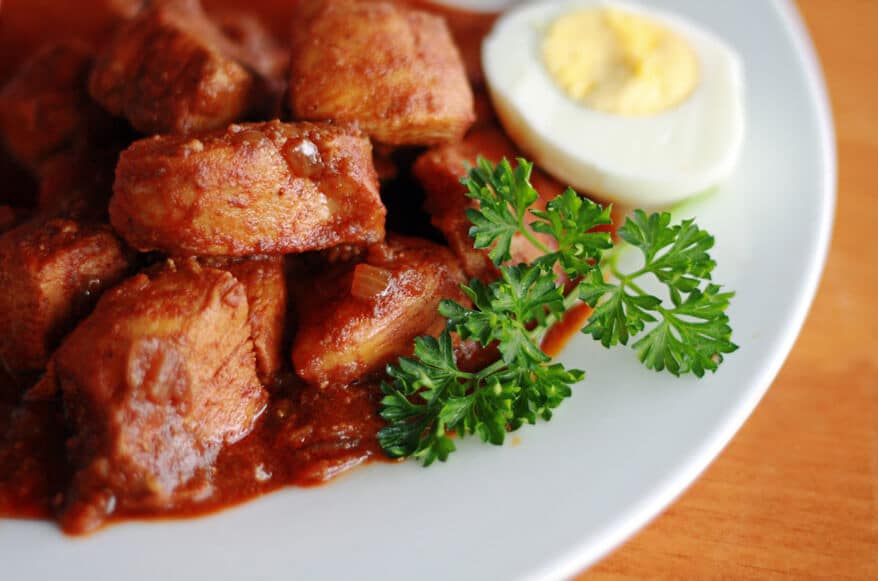
Doro Wat is one of the most famous of all African dishes. You will find it in every Ethiopian restaurant and virtually anyone who is familiar with African cuisine will have heard of it. Another version, though not as commonly known here, is Sega Wat, made with beef (fyi, you’ll find recipes online calling it Sik Sik Wat, but I’ve confirmed with the chefs of several Ethiopian restaurants that it’s Sega Wat). You can directly substitute beef for chicken and follow the same cooking instructions.
Doro Wat is traditionally made very spicy. Super spicy. Like I-don’t-know-how-Ethiopians-have-any-taste-buds-left spicy. Western adaptations are still spicy, but quite tame compared to the real deal.
This recipe for Doro Wat comes by way of request from Jared (Make a Request!). He said he has been trying for several years to find a good recipe. Jared, this recipe is both authentic and delicious – I think you’ll be very happy with it!
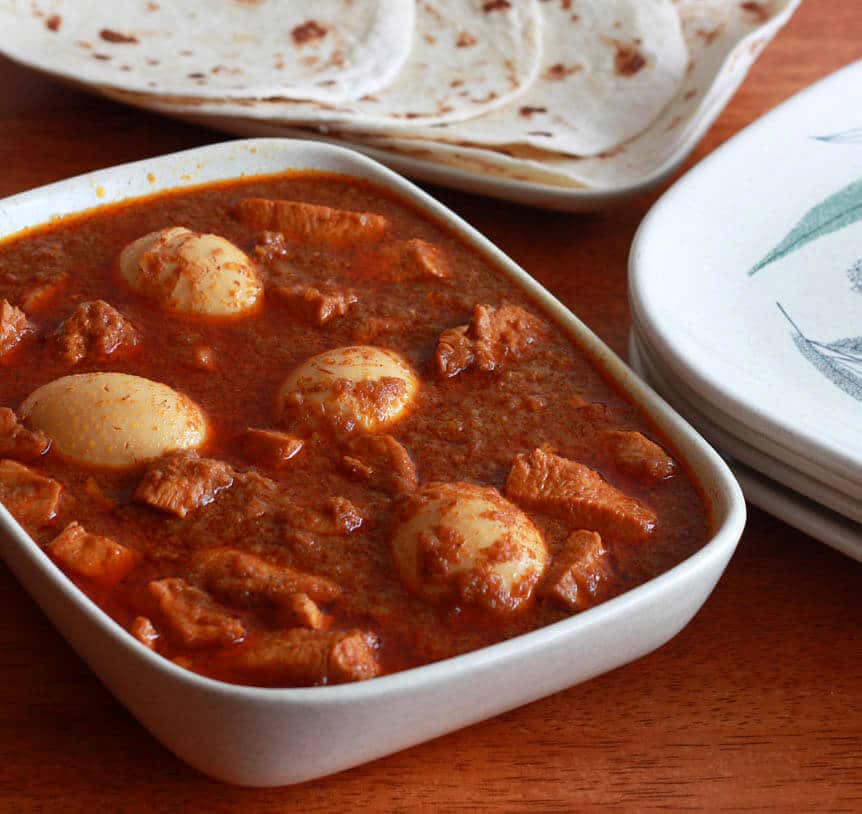
Traditionally Doro Wat is served with an Ethiopian flatbread called injera. It’s kind of a spongy pancake made with teff flour (a grain indigenous to the area), and the batter is left to ferment for up to 4 days before its used. The injera is used in place of an eating utensil and is used to scoop up the chicken stew.
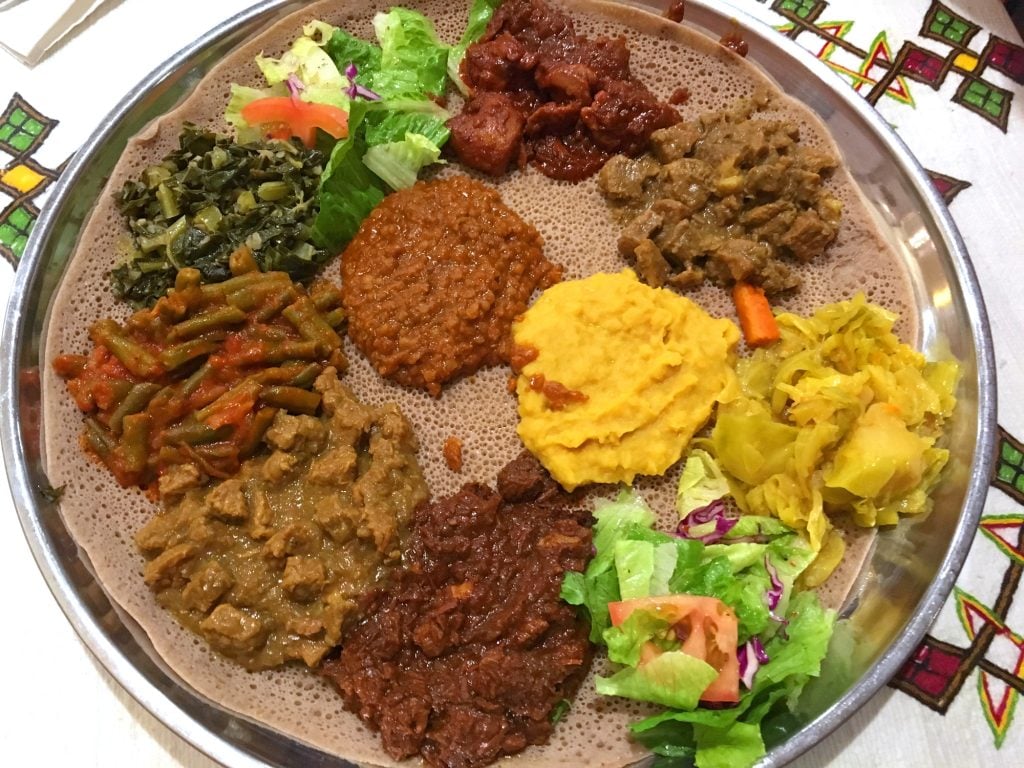
Doro Wat Key Ingredients
The key to authentic, great-tasting Doro Wat is good quality, flavorful berbere, and a very long cooking process. It can take several hours for an Ethiopian to make Doro Wat. You can cut back on the cooking time and your Doro Wat will still taste good, but it won’t taste like it’s supposed to. The magic is in the slow-cooked onions. And it takes time for the magic to happen.
A central ingredient of Doro Wat is Berbere, a fiery, bright red and flavorful Ethiopian spice blend. It is best made fresh using whole spices that are toasted and ground for maximum flavor. A combination of whole and ground spices are used as seen in the picture below.

The whole spices are toasted and ground up with the already ground spices to make a beautiful, aromatic, flavorful and spicy seasoning blend.
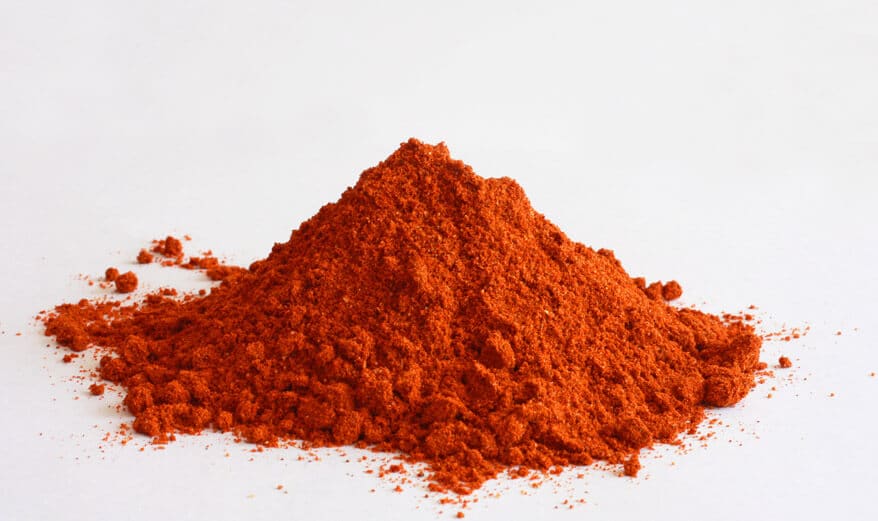
Purchasing these spices will serve you well as each of them are commonly used in a large variety of other cuisines. Stored in airtight glass jars in a dark place, they will keep a very long time. If you’d rather purchase berbere, you can find it online. You need 1/4-1/3 cup for this recipe alone, so forget the tiny 2-3 oz jars of it you usually find for sale. The best deal I’ve found for bulk berbere (and it also happens to be organic and a reputable brand) can be found HERE.
Berbere makes a great rub for meat, poultry, and fish, as well as a seasoning for stews, soups, and vegetables. It’s a great all-purpose spice, so you’ll be able to make good use of this bulk package if you decide to buy versus make your own.
Another key ingredient in Doro Wat and Ethiopian cooking at large is niter kibbeh, a seasoned clarified butter. You can find it in Indian grocery stores and well-stocked Asian markets, but as always I strongly recommend making your own for the best flavor. Check out my recipe for homemade Niter Kibbeh!

Doro Wat Recipe
Let’s get started!
Use a food processor to very finely mince the onion – you want an almost chunky puree.
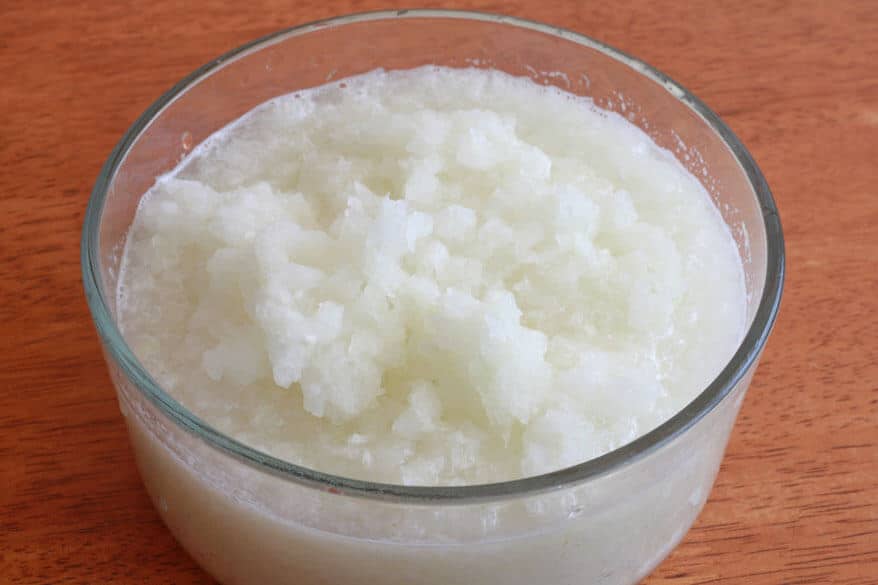
Heat 2 tablespoons of oil and 2 tablespoons of niter kibbeh in a Dutch oven and saute the onion, covered, over low heat for 45 minutes, stirring occasionally. Add more niter kibbeh if it gets too dry.
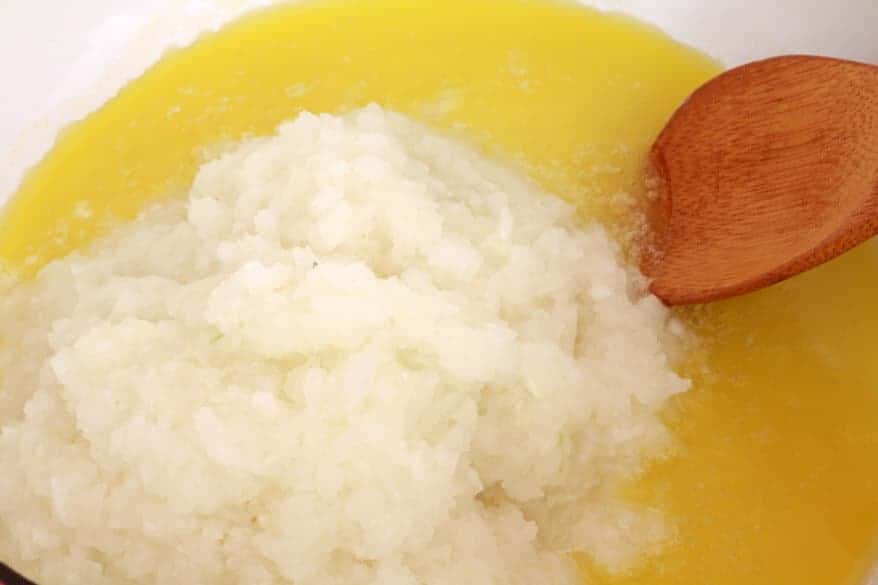
In the meantime, finely mince the garlic and ginger.
Add the garlic, ginger, and 1 tablespoon of butter. Continue to saute, covered, over low heat for another 20 minutes, stirring occasionally.
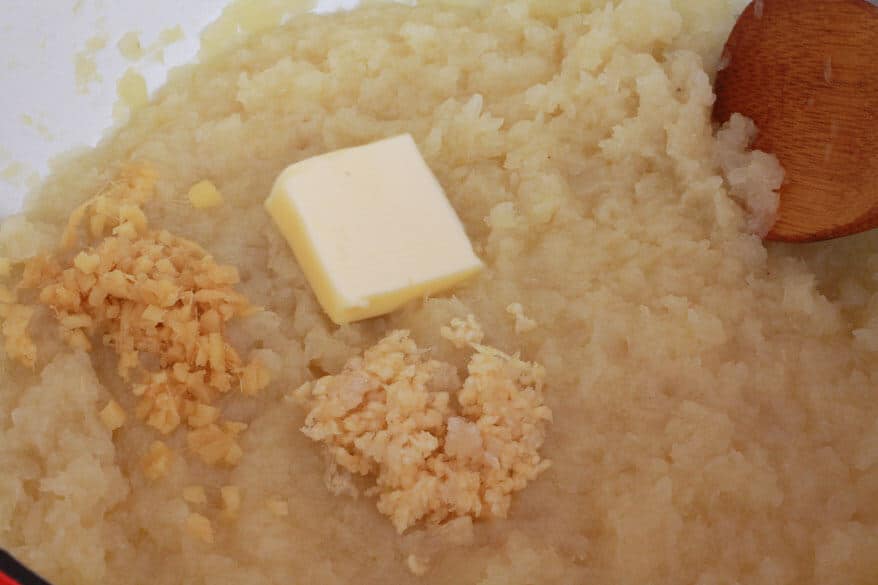
Add 4 tablespoons of berbere and 2 teaspoons salt and stir to combine.
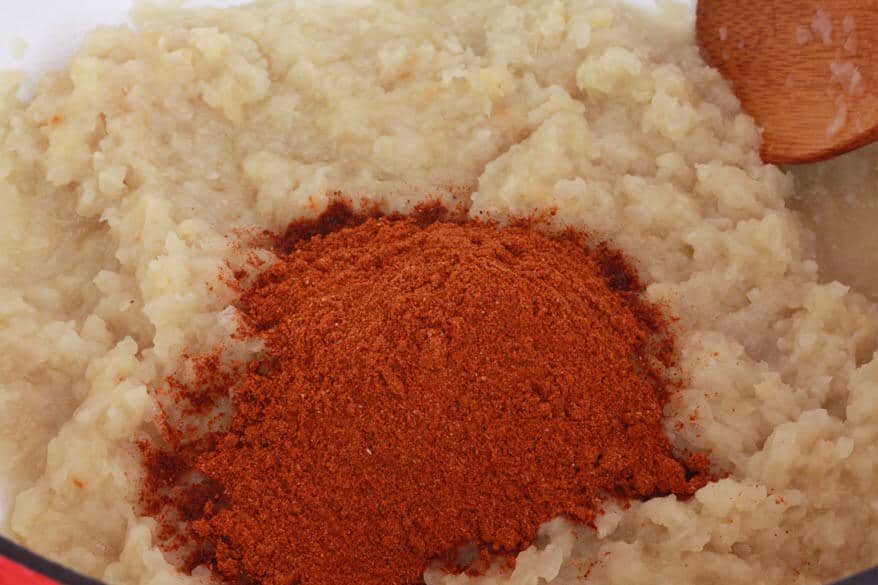
Add 2 tablespoons of butter, cover, and simmer over low heat for another 30 minutes, stirring occasionally.
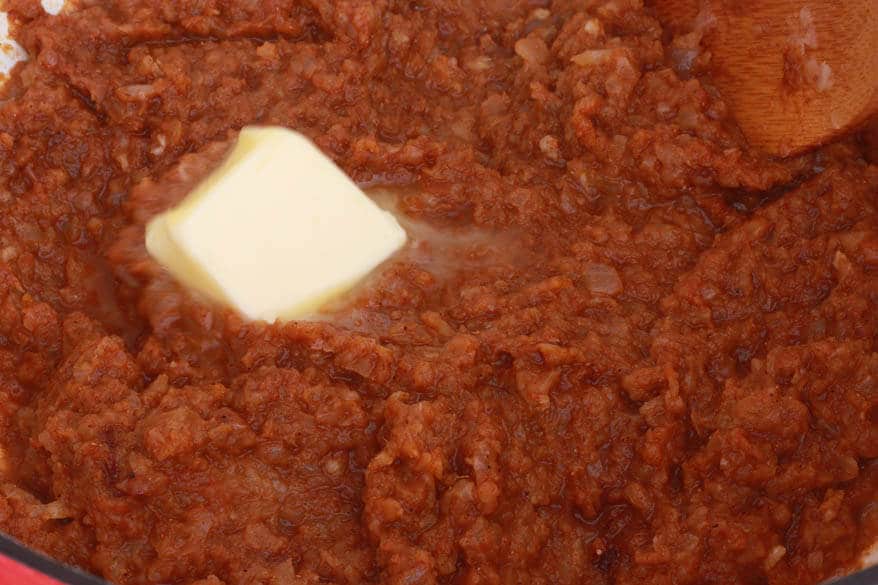
After 30 minutes you’ll have a rich and luscious sauce that’s ready for the chicken!
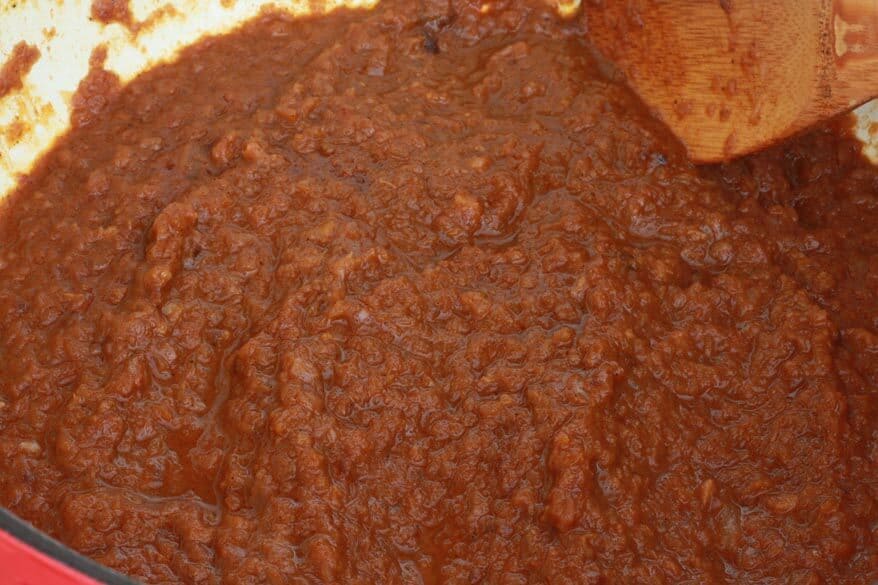
Traditionally, bone-in, skin-on chicken pieces are used. You can either use chicken thighs, cut into 1 inch chunks, or use boneless chicken breast. I used breast this time. Cut the breast into small, 1/2 inch chunks. Place the chunks in a dish with 2 tablespoons lemon juice and let sit at least 15 minutes.
Add the chicken to the sauce.
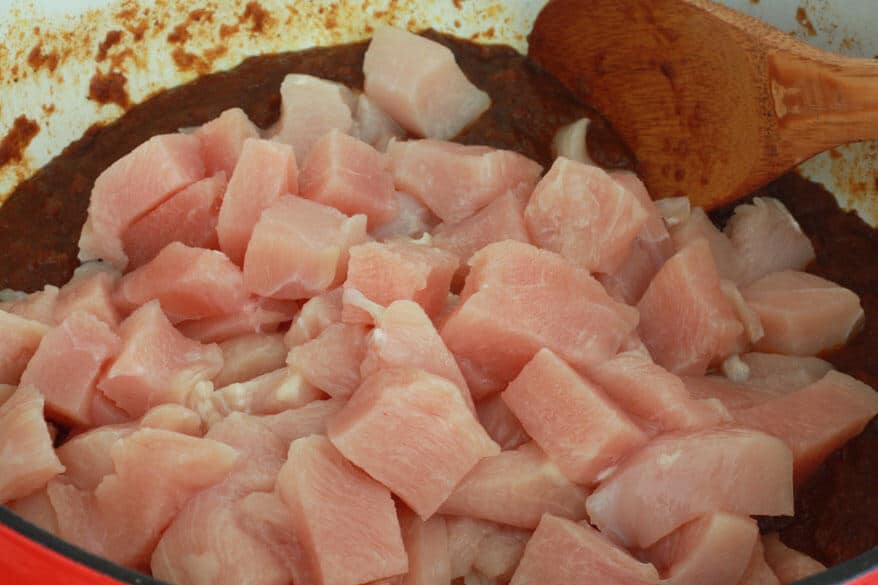
Traditionally, Tej is used, an Ethiopian honey wine. If you have access to it, use it. Alternatively you can substitute white wine with a teaspoon of honey.
Add the chicken stock, salt and honey wine to the mixture. Bring to a boil, reduce the heat to low, cover, and simmer for 45 minutes, stirring occasionally.
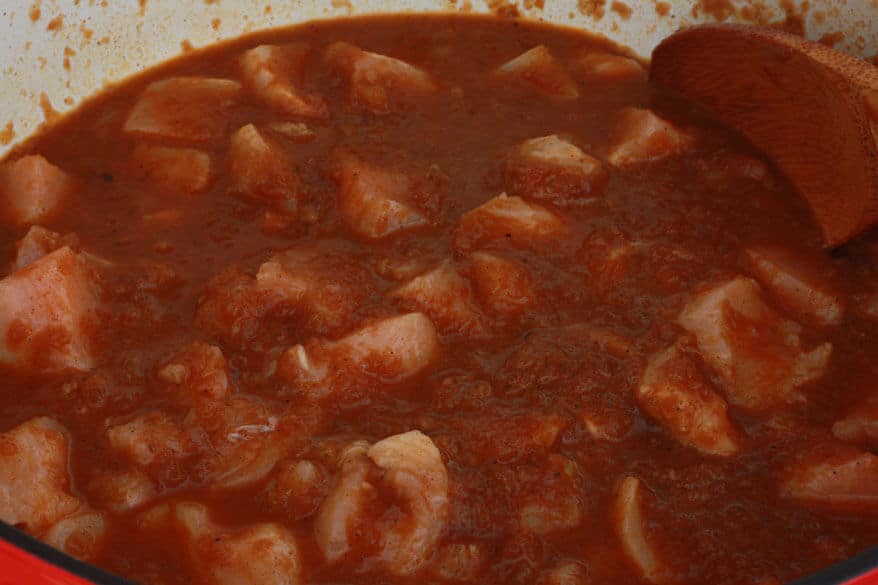
In the meantime, boil the eggs. Once the eggs have cooled enough to handle, peel and pierce them all over with a fork, about 1/4 inch deep, to allow the sauce to penetrate.
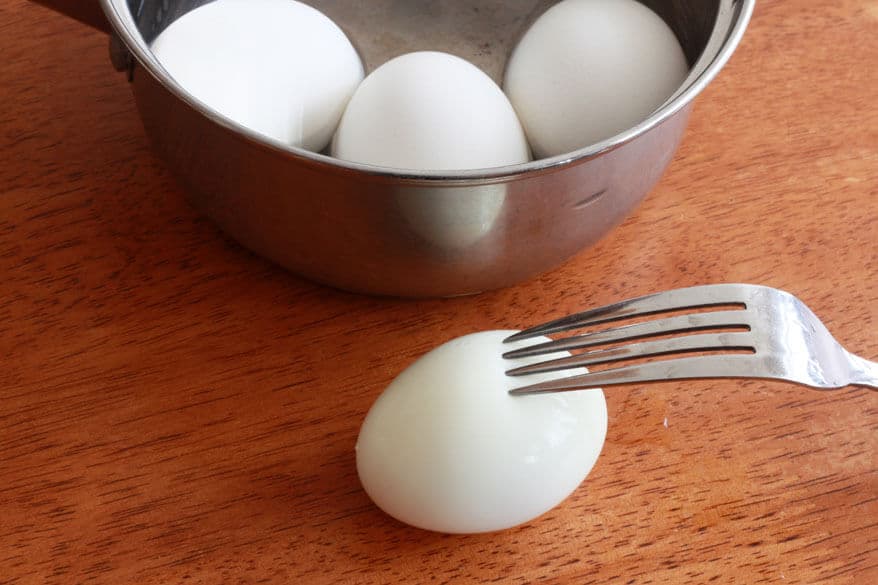
After 45 minutes you’ll have a rich, luscious spicy chicken stew ready for the eggs!
Add the eggs and continue to simmer, covered, over low heat for 15 minutes, stirring occasionally. Adjust the seasonings according to taste. Add more berbere according to heat preference.
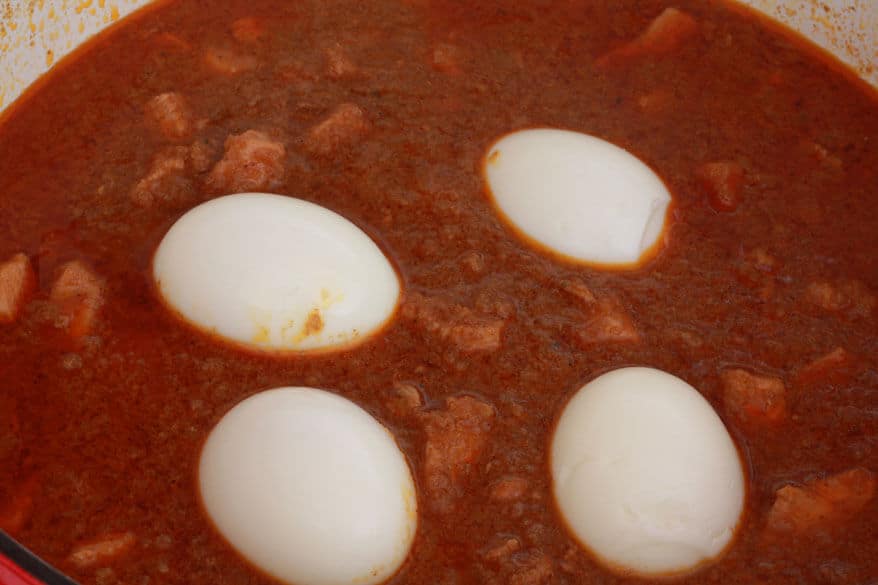

Serve with Authentic Injera (Ethiopian Flatbread).
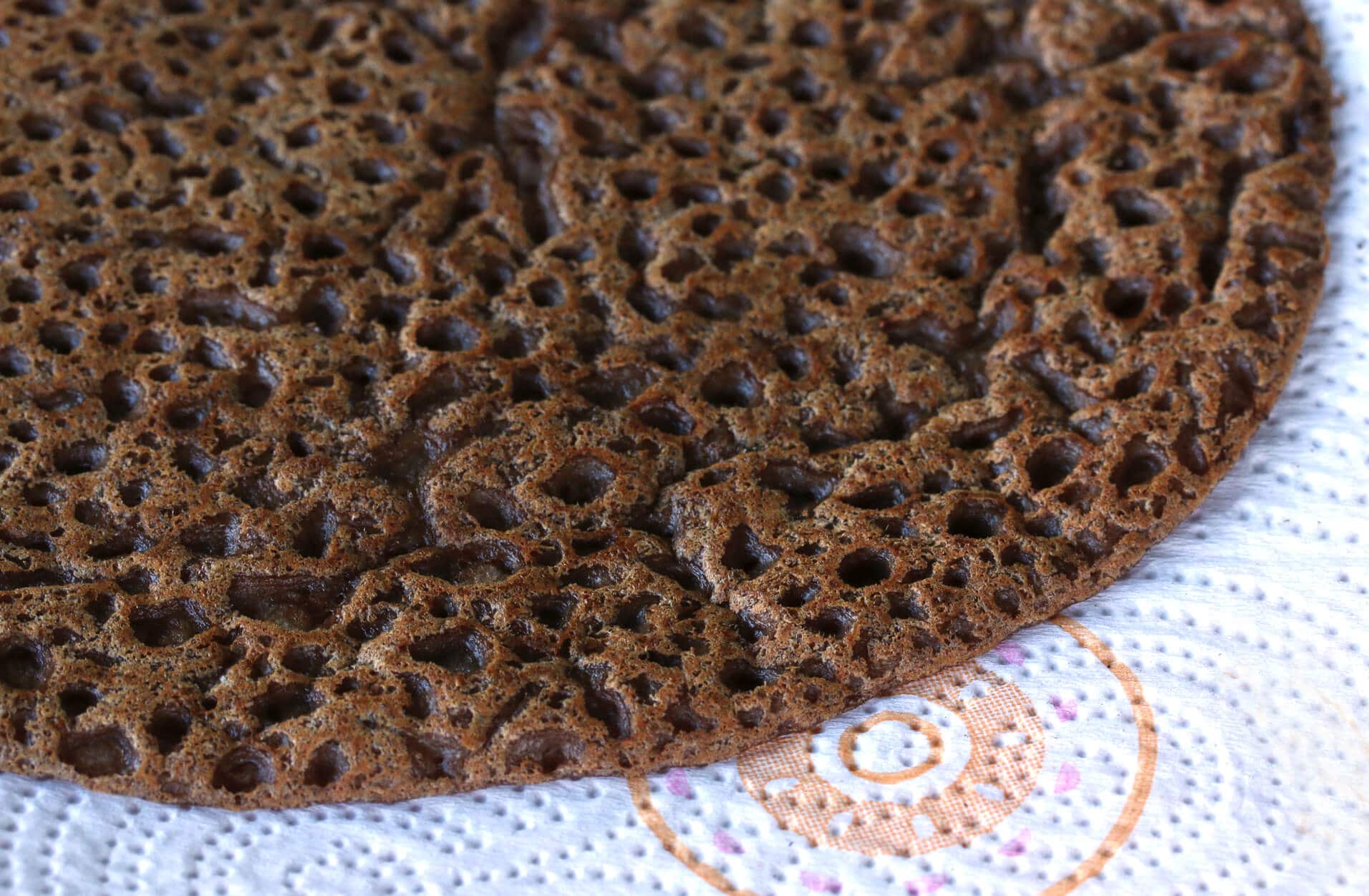
Be sure to also try our authentic Sega Wat, the famous and incredibly delicious Ethiopian spicy beef stew!
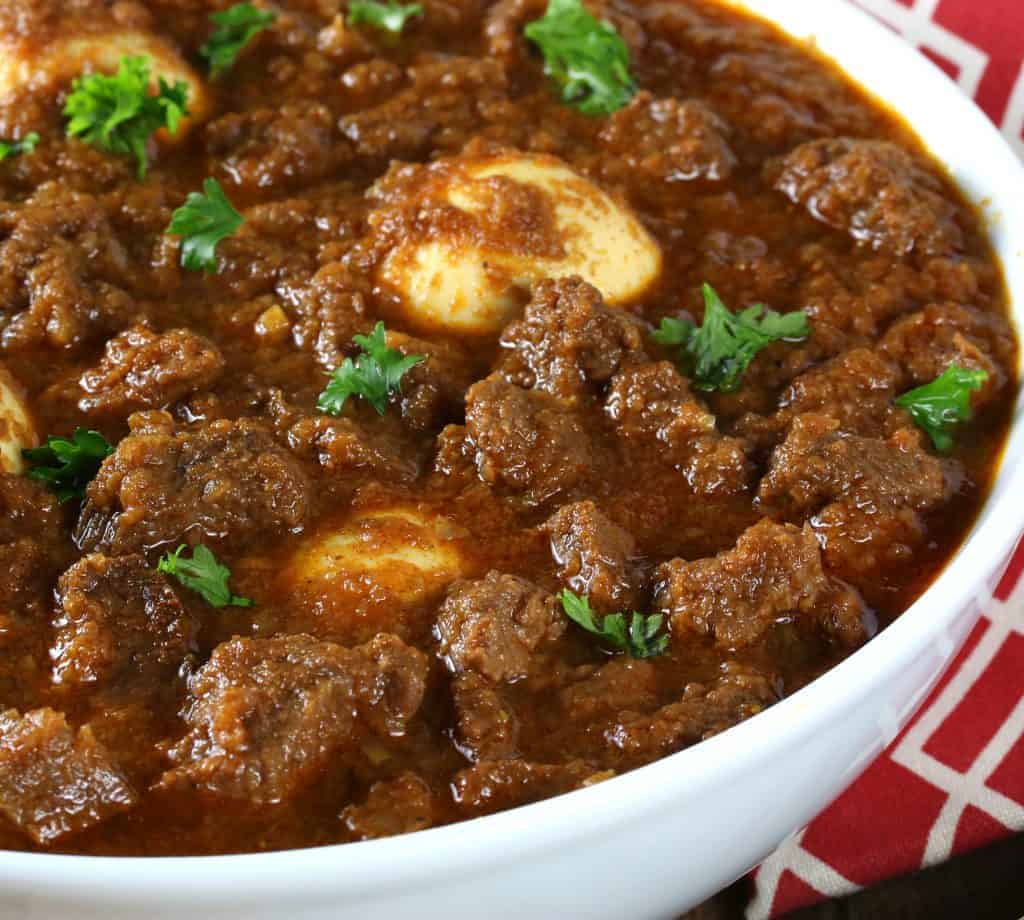
Lastly, for an authentic Ethiopian side dish to serve with your doro wat, try our Gomen (Ethiopian Collard Greens)!
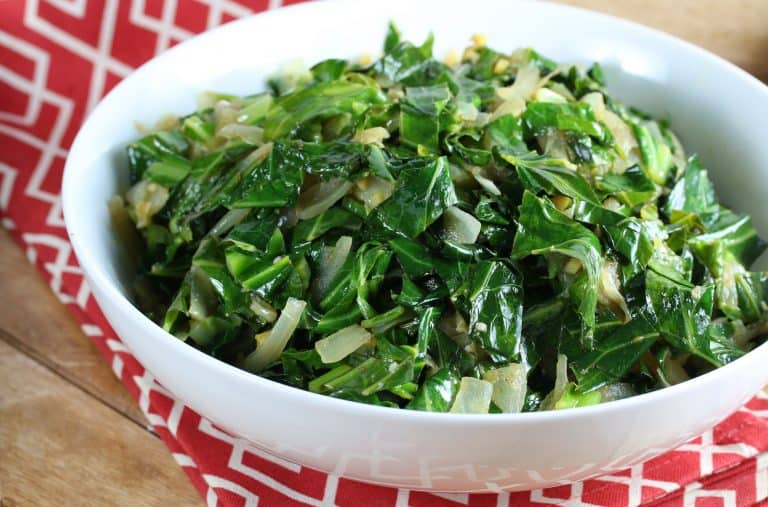
Save This Recipe
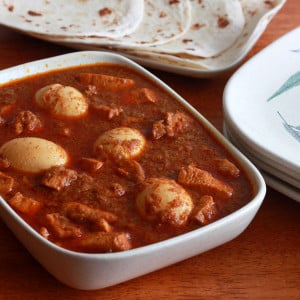
Doro Wat (Ethiopian Spiced Chicken)
Equipment
Ingredients
- 3 lbs chicken thighs , cut into 1 inch pieces, or 3 chicken breasts, cut into 1/2 inch pieces
- 2 tablespoons fresh lemon juice
- 2 tablespoons niter kibbeh
- 2 tablespoons extra virgin olive oil
- 3 cups chopped yellow onions
- 3 tablespoons butter
- 1 tablespoon finely minced garlic
- 1 tablespoon finely minced ginger
- 1/4 cup Ethiopian berbere
- or use HOMEMADE BERBERE (HIGHLY recommended!)
- 1 1/2 teaspoons salt
- 1/2 cup Tej (Ethiopian honey wine) (alternatively you can substitute white wine mixed with 1 teaspoon honey)
- 1 cup chicken stock
- 4 hard-boiled eggs , pierced all over with fork about 1/4 inch deep
Instructions
- Place the onions in a food processor and finely mince them to a chunky puree. Set aside.Place the chicken pieces in a bowl and pour lemon juice over. Let sit at room temperature for at least 30 minutes.
- Heat the niter kibbeh or butter along with the olive oil in a Dutch oven or heavy pot. Add the onions and saute, covered, over low heat for 45 minutes, stirring occasionally.Add the garlic, ginger, and 1 tablespoon butter and continue to saute, covered, for another 20 minutes, stirring occasionally. Add the berbere and the 2 remaining tablespoons of butter and saute, covered, over low heat for another 30 minutes, stirring occasionally.Add the chicken, broth, salt and wine and bring to a boil. Reduce the heat to low, cover, and simmer for 45 minutes, stirring occasionally.Adjust the seasonings, adding more berbere according to heat preference. Add the boiled eggs and simmer on low heat, covered, for another 15 minutes.
- Half or quarter the eggs and arrange on the plates with the stew. Serve hot with injera, bread or rice.
Nutrition
Originally published on The Daring Gourmet August 27, 2013



















This was absolutely incredible and better than any restaurant version I’ve ever had, thank you!!
I’m so happy to hear that, Candace, thank you!
When you say Thighs, do you mean boneless and skinless? 2 1/2 lbs sounds like a lot for people. It looks good tho
Hi Irma, cutting them into 1-inch pieces implies that they’re boneless but you can certainly use larger bone-in pieces as well. In terms of servings, this stew doesn’t stretch as far as you might think since there are no additional veggies or ingredients and it’s the chicken that’s the main ingredient.
Have had this recipe saved for awhile but just tried it for the first time – delicious! I spent a summer in Ethiopia years ago and fell in love with the country and the people. We order take out from an Ethiopian restaurant in town every so often, but it was fun to make a dish on my own! Thanks for the recipe. :)
Wonderful, Maggie, I’m so glad you enjoyed it and appreciate the feedback – thank you!
Just made it and it was fantastic. Great amount of spice. This is the best thing I’ve made in weeks. Thanks for the recipe!
Wonderful, Ben, thank you!
I was with you for the injera recipe, but the doro wat recipe disapointed me. Just from the picture alone I could tell the colour of the doro wat was off. Then I read the recipe and I was doubly disapointed. You skipped two essesntial steps for the authentic flavour. Soaking the chicken in lemon juice and salt first and using Niter Kibbeh instead of butter. Yes, it takes more time, but it is worth it!!
Natalie, I’m not sure which doro wat recipe you read, but it certainly wasn’t mine. Look again and you’ll see that this recipe calls for both lemon juice and niter kibbeh.
Made this tonight! It was excellent! Not *quite* as dark and rich as the doro wat I’ve had from Ethiopian places, but the flavor was amazing, and, to be fair, I didn’t have niter kibbeh or tej. Served it with jasmine rice (no injera) and my husband loved it! (It was his first time eating Ethiopian food.) Excellent recipe- will definitely use this as a go-to.
Wonderful, Christie, I’m so glad you enjoyed it, thank you!
I made this today because I had left over Berbere from another recipe. I totally savoured this dish and even my hubby, who is not as adventurous as I am in the foodie department, enjoyed it. Next time, I will make up your version of the spice blend to see how it differs from the combo I had. Thank you for publishing this recipe!
Wonderful! I’m so happy to hear that, Danni, thank you! And yes, I’d love to hear your thoughts once you’ve had the chance to compare the seasonings.
The higher saute heat temperature does cause the berbere to go to a very dark red,almost browned color. (Not smoked, or hungarian hot) Paprika as a closer/finishing spice is a perfect way to bring back a nice red color,without adding any more real heat. Or a bright red chili powder blend like Dallas Dynamite from Pendery’s. Color is alot easier than flavor. ;)
Thanks for the tip!
You’re welcome :)
This youtube vid https://youtu.be/BQ5wsYu_VK by some english guy would be very helpful to anyone’s first try at doro wat. He also uses Mekelesha, one of the most unique spice blends I have ever used (as is berbere). Especially to illustrate how important the onions being cooked correctly is, and whether this dish succeeds or flops. I stick to just skinned chicken legs for this; any meat/poultry bone-in is always more flavorful and in the case of doro wat it is apparently the most authentic version. (And obviously the cheapest and easiest to share,as well).
My Ethiopian coworker has promised me some of his mother’s (old lady from ethiopia) real deal homemade Kibbeh. Any other dishes you can suggest? I was thinking I may try spicy Sega Wat or Peanut stew.
Thanks for the additional info, Clone. That’s awesome that you have access some homemade kibbeh! I’ve been meaning to post a “how to” post for making homemade kibbeh on here, I’ve made a note. It’s really quite easy, it’s just a matter of having the right spices.
My favorite peanut stew is a Gambian one, it’s a dish my husband frequently requests called Domoda: http://www.daringgourmet.com/domoda-gambian-peanut-stew/. It’s a very simple stew, not nearly as complex in process or flavor as Doro Wat, but it’s a lovely dish.